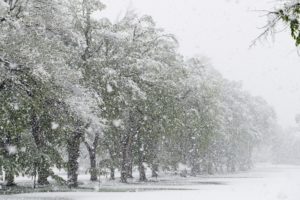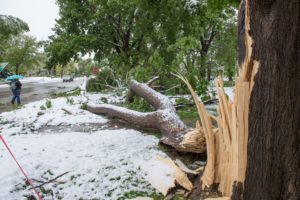On a campus known for its lovely green canopy of trees, limbs strewn across the ground are obvious collateral damage of this week’s late spring storm.
Fred Haberecht, assistant director of Facilities Management and campus planner, says about 800 of the 6,000 trees on the main campus are heavily damaged and will need to be removed or significantly pruned.
Haberecht also confirmed good news: The historic Oval trees came through the storm.
 “The historic Oval trees are largely not impacted,” he said. “We’ve proactively pruned them and those efforts have paid off. We did lose some of the smaller trees planted in the Oval on Arbor Day about five years ago. We’ll need to remove and replace three or four of those.”
“The historic Oval trees are largely not impacted,” he said. “We’ve proactively pruned them and those efforts have paid off. We did lose some of the smaller trees planted in the Oval on Arbor Day about five years ago. We’ll need to remove and replace three or four of those.”
The Oval Preservation Fund will pay to purchase those replacement trees, and also supports the regular maintenance and pruning program that helped protect the trees from significant damage. Costs of addressing other tree damage will be mitigated by insurance.
Rare May storm brings widespread moisture
The rare late May storm caused the closure of the Oval and then the entire campus on May 18 due to safety concerns from heavy snow on trees, possibly the university’s first closure due to snow during summer session. By 8 p.m. Thursday evening, the CSU weather station reported 5.8 inches of snow and 2.77 inches of precipitation, with up to 8 inches reported in other city locations.
The university arborist, Facilities Management staff and tree care contractors met at 6:30 a.m. May 19 to assess damage and develop a mitigation plan. They also taped off areas where trees presented the most immediate safety risk before campus reopened on a normal schedule.
Arborist crews addressing safety first
Arborist crews are posed to start working as soon as it is safe – likely early this afternoon— once snow has melted from the trees and diminished the threat of pulling down additional branches. Addressing immediate safety concerns will take days, with work anticipated to extend all weekend and into Monday.
Crews will focus first on the most significant safety issues such as hanging limbs over sidewalks and parking lots, as well as clearing the Moby Arena parking lot and surrounding area for Poudre School District graduations, which begin at 6:30 p.m. Friday. Haberecht said that work to remove or prune trees where damage isn’t an immediate safety threat will continue across campus for at least a month.
Haberecht said damage is primarily to two species of trees; ash and hackberry, because they were more fully leafed out than other trees. The greatest concentration of ash trees is along Shields, Laurel, Piktin and Plum streets, and in housing areas. Hackberry trees are spread widely across campus.
“One historic hackberry tree on the south side of Student Services was lost due to severe damage,” Haberecht said. “It was likely at least 70 years old.”

This storm has potentially been the worst in decades for ash trees because many were in full leaf. Because of the impact of the emerald ash borer, a portion of ash trees on campus were slated for removal over the next several months.
Not first damaging spring snow for University trees
Historically, trees on campus have seen their share of storms. In 1978, another May storm brought more snow than this storm, resulting in more damage. Historical records of similar storms in the 1930s and earlier document other damaging snowfalls.
“As long as there has been a campus, we’ve experienced these kinds of storms,” Haberecht said.
Haberecht believes that flowerbeds and other plants across campus will mostly bounce back, with the exception of some annual flowers, among them the flowers spelling out “CSU” along College Avenue. They will likely need to be replaced.
As of early May 19, Facilities has not received reports of flooding in buildings on campus, but have had calls of roof leaks. They continue to monitor for issues.
The Colorado State Forest Services is offering tips to residents on how to deal with snow-damaged trees at home.